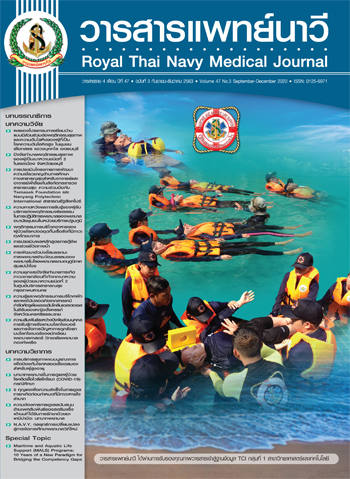The Development of Indicators on Transcultural Nursing Competence of Nurses in Hospital in the Greater Mekong Subregion (GMS)
Main Article Content
Abstract
The objectives of this research were to 1) develop the indicators on transcultural nursing competence of nurses in hospitals in the Greater Mekong Subregion (GMS); 2) examine congruence between the structural model of the developed indicators on transcultural nursing competence of nurses in hospitals in the GMS and the empirical data and 3) develop a manual on the use of indicators on transcultural nursing competence of nurses in hospitals in the GMS. The research was conducted with a mixed methodology and was divided into 3 phases. Research conceptual framework building and indicator development was completed in the first phase by the studying of relevant documents and research papers, the interview with 7 qualified persons and the 3-time application of modified Delphi technique by 21 experts. The second phase was investigating the research hypothesis with empirical data by asking 503 of registered nurses. Registered nurses who had the working experience of no less than 3 years in hospitals in the GMS were selected. The third phase was a manual development for the use of developed indicators, which was verified by 5 experts. The tool employed was a 5-level rating scale questionnaire. Confirmatory factor analysis was carried out to verify the congruence between the developed structural model and empirical data. The appropriateness of the developed manual was assessed by using mean and standard deviation.
The research results are as follows.
1. Transcultural nursing competence of nurses in hospitals in the GMS comprised 5 main components, 15 sub-components and 73 indicators, which can be classified as 1) 3 sub-components and 14 indicators on competency in nursing practice implementation; 2) 3 sub-components and 16 indicators on risk management; 3) 3 sub-components and 15 indicators on ethics and professional ethics; 4) 3 sub-components and 16 indicators on communication and 5) 3 sub-components and 12 indicators on perception on cultural differences in person.
2. The developed structural model on on transcultural nursing competence of nurses in hospitals in the GMS showed congruence with the empirical data with chi-square = 21.00, df = 33, p-value = 0.88, GFI = 0.99, AGFI = 0.95 and RMSEA = 0.00.
3. The overall appropriateness of the developed manual on the use of indicators on transcultural nursing competence of nurses in hospitals in the GMS was at a high level.
Article Details

This work is licensed under a Creative Commons Attribution-NonCommercial-NoDerivatives 4.0 International License.
References
2. Kupattanakun S. Working of foreigners. Journal of the situation of the labor market in the Northeast region 2019;11(3):1-6. (in Thai).
3. Wangthong A, Wangthong A, Watsen T, Suttarangsri W. Clients’ perspectives on humanized nursing care within a multicultural context: a case study of Nongjik District Pattani Province. Nursing Journal of the Ministry of Public Health 2013;48(26):35-44. (in Thai).
4. Puttaruksa L, Khumyu A, Chaisena J. The development of performance criteria and standards for transcultural nursing services. Nursing Journal of the Ministry of Public Health 2015;27(1):168-84. (in Thai).
5. Tiyawisutsri C, Pakdeewong P, Wannapornsiri C. Multicultural nursing: the competencies required for nurses in Thailand. Journal of Health Science Research 2016;10(1):8-15. (in Thai).
6. Chutip P. The development of transcultural nurses’ competency assessment scale of professional nurses in private hospital. Journal of Nursing and Health Care 2016;34(1):170-8. (in Thai).
7. Leamwuthiwattana J, Siriphan S. Cultural competency of registered nurses of Obstetric Department in Naradhiwas Rajanagarindra hospital. Journal of Naradhiwas Rajanagarindra 2017;4(3):14-28. (in Thai).
8. Leininger M. Cultural care theory: a major contribution to advance transcultural nursing knowledge and practice. Journal of Transcultural Nursing 2002;13(2):189-192.
9. College of Nurses of Ontario. A guide for nurses for providing culturally sensitive care. [Internet]. [cited 2020 April 20]. Available from: https://www.yumpu.com/en/document/read/8258620/practice-guideline-culturally-sensitive-care-college-of-nurses-
10. Campinha-Bacote J. The process of cultural competence in the delivery of healthcare services: a model of care. Journal of Transcultural Nursing 2011;13(3):181-4.
11. Potipactsa G. Transcultural perspective on nursing care of children and family. Journal of Sakonnakhon Hospital 2016;10(3):236-46. (in Thai).
12. Inpalat A, Jantasan S,Sangson S,Wonngsricha S, Suwanpakdee M, Sumethanurakkakul W, et al. A study of registered nurses’ opinions on transcultural nursing competencies Udon Thani hospital. Journal of Sakon Nakhon Hospital 2016;9(2):1-11. (in Thai).
13. Krutsutthipipat C, Wivatvanit S. Transcultural nursing outcome indicators. Journal of Nursing Science Chulalongkorn University 2017;29(3):19-29. (in Thai).
14. Youwattana P, Prachusilpa G. Relationships between personal factors, workplace environments, transformational leadership of head nurses, and transcultural nursing competencies of professional nurses private hospitals Bangkok Metropolis. Journal of The Royal Thai Army Nurses 2017;18(2):174-84. (in Thai).
15. Hair JF, Black WC, Babin BJ, Anderson RE. Multivariate: data analysis. 7th ed. New Jersey : Upper Sandler ever Pentice Hall; 2010. p.599-638.
16. Wolf EJ, Harrington KM, Clark SL, Miller MW. Sample size requirements for structural equation models: an evaluation of power, bias, and solution propriety. Educ Psychol Meas 2013;73(6):913-34.
17. Srisa -Ard B. Preliminary research. 9th ed. Bangkok: Suriyasan; 2015. (in Thai).
18. Srisuchad K , Pollaharn C, Wongkasem C. The development of indicators of safety school guide of the Basic Education Commission Office. RMU.J. (Humanities and Social Sciences) 2016;10(3):257-72. (in Thai).
19. Nanthasri T, Pengsawat W, Chalakbang W, Satheannopakaow P. The development of indicators on innovative leadership of school directors under Offices of Primary Education Service areas in the Northeast of Thailand. Social Sciences Research and Academic Journal 2019;14(3):93-106. (in Thai).
20. Chaiwut S, Markmee K, Kosanpipat S. The development of an academic management handbook for Education Faculty Chiang Mai Rajabhat University. Journal of The Pikganesh 2017;13(2):129-47. (in Thai).


